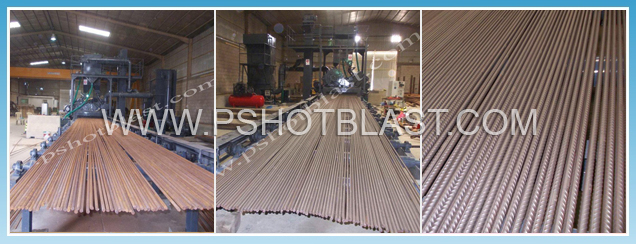| |
Shot Blast cleaning is the most commonly used method for preparation of steel surfaces. This effectively removes rust, scale, slats, and makes surface rough (rough surface is called profile). Profile increases the effective surface area of the steel. The cleanliness achieved is assessed to by Swedish standard from a set of photographic slides in Swedish standard (SIS) showing examples of the common terminology of white-metal, near white-metal, etc. Typically, SA 2½ is used for pipelines (equivalent to NACE N°2).
It is important to remove grease or oil contamination prior to blast cleaning. Solvent cleaning, burn-off, etc., are commonly used for this purpose. In the blast cleaning process, a blasting wheel uses centrifugal force to propel the abrasive against rebar in controlled direction, speed and quantity. The equipment is equipped with 4 blast wheels. 2 blast wheels are mounted on the top of the cabinet and positioned above the pass line of the work and the other 2 Blast wheels are mounted in the bottom of the cabinet positioned below the pass line of the rebar. Blast Wheel position and angel are strategically designed in such a way that the abrasive blast pattern covers the entire surface multiple re-bar. |

 Tumble Blast Machines
Tumble Blast Machines Swing Table Shot Blasting Machines
Swing Table Shot Blasting Machines Multi Table Shot Blasting Machines
Multi Table Shot Blasting Machines Shot Blasting for Aluminum Casting
Shot Blasting for Aluminum Casting Spinner Hanger Type Shot Blasting Machines
Spinner Hanger Type Shot Blasting Machines Door Hook Type Shot Blasting Machines
Door Hook Type Shot Blasting Machines Continues Monorail Shot Blasting Machines
Continues Monorail Shot Blasting Machines Roller Conveyor Shot Blasting Machines
Roller Conveyor Shot Blasting Machines Pipe Shot Blasting Machines
Pipe Shot Blasting Machines Plate Shot Blasting Machines
Plate Shot Blasting Machines Strip Shot Blast Machines
Strip Shot Blast Machines Stones and Ceramic Blasting Equipments
Stones and Ceramic Blasting Equipments Cylinder Shot Blasting Machines
Cylinder Shot Blasting Machines Coil & Wire Shot Blast Machines
Coil & Wire Shot Blast Machines Bar Shot Blasting Machines
Bar Shot Blasting Machines Wire Rod Shot Blasting Machine
Wire Rod Shot Blasting Machine Billet Shot Blasting Machines
Billet Shot Blasting Machines Wire Mesh Belt Shot Blasting Machines
Wire Mesh Belt Shot Blasting Machines Shot Peening Machines
Shot Peening Machines Roll Etching Machines
Roll Etching Machines Railway Shot Blasting Equipments
Railway Shot Blasting Equipments  Steel Mill Equipments (Special Machines)
Steel Mill Equipments (Special Machines) Blast Rooms/Plants
Blast Rooms/Plants Pressure and Suction Blast Hand Cabinets
Pressure and Suction Blast Hand Cabinets Paver Block Shot Blasting Machine
Paver Block Shot Blasting Machine Sand Blast Pot Machines
Sand Blast Pot Machines Shot Blast Wheels
Shot Blast Wheels Dust Collectors
Dust Collectors Abrasives
Abrasives Spare Parts & Accessories
Spare Parts & Accessories ReBar Epoxy Coating
ReBar Epoxy Coating ReBar / TMT Shot Blasting Machine
ReBar / TMT Shot Blasting Machine Aluminum Profile Shot / Sand Blasting Machine
Aluminum Profile Shot / Sand Blasting Machine Scaffolding Cleaning Shot Blasting Machine
Scaffolding Cleaning Shot Blasting Machine
